Leadership and Management Essay
VerifiedAdded on 2020/12/24
|17
|4202
|458
Essay
AI Summary
This essay explores the concepts of leadership and management, examining their distinct roles and characteristics. It analyzes various leadership theories and highlights the key differences between leadership and management, emphasizing their complementary roles in achieving organizational goals.
Contribute Materials
Your contribution can guide someone’s learning journey. Share your
documents today.

Leadership and
Management
Management
Secure Best Marks with AI Grader
Need help grading? Try our AI Grader for instant feedback on your assignments.

Table of Contents
MAIN BODY...................................................................................................................................1
1-What is involved in being a successful leader?.......................................................................1
2.Can good leadership be developed and if so, how?.................................................................1
3. What distinguish leadership from management?....................................................................2
4)What have you learnt about leadership from your own experiences, on this course and
elsewhere?...................................................................................................................................5
CONCLUSION................................................................................................................................6
REFERENCES................................................................................................................................7
MAIN BODY...................................................................................................................................1
1-What is involved in being a successful leader?.......................................................................1
2.Can good leadership be developed and if so, how?.................................................................1
3. What distinguish leadership from management?....................................................................2
4)What have you learnt about leadership from your own experiences, on this course and
elsewhere?...................................................................................................................................5
CONCLUSION................................................................................................................................6
REFERENCES................................................................................................................................7

MAIN BODY
1-What is involved in being a successful leader?
Leader is the person who works to provide guidance to team mates which assist in getting
positive outcome. Team is group of two or more individuals which works in achieve common
aims and objectives. There are different individuals having difference in their knowledge,
experience, working style, etc. Hence in this case, role of leader is important and significant
which assist in achieving targets within specified time with goals and objectives (Avolio and
Yammarino, 2013). There is requirement of some skills to become successful leader, some
theories are discussed under which assist in becoming successful leader. Some of them as under-
INDIVIDUAL
Traits- Traits are the skills which is differ from one individual to another and makes him
different from others. This is the quality which makes individual distinguish from others. These
are the characteristics, attributes, features which makes candidate different from others.
Big Five Personality
As per this model, there are five types traits such as openness to experience,
conscientiousness, etc. This model is also known as OCEAN model. This theory is discussed as
under-
(Source: Big Five Personality, 2018)
1
Illustration 1: Big Five Personality
1-What is involved in being a successful leader?
Leader is the person who works to provide guidance to team mates which assist in getting
positive outcome. Team is group of two or more individuals which works in achieve common
aims and objectives. There are different individuals having difference in their knowledge,
experience, working style, etc. Hence in this case, role of leader is important and significant
which assist in achieving targets within specified time with goals and objectives (Avolio and
Yammarino, 2013). There is requirement of some skills to become successful leader, some
theories are discussed under which assist in becoming successful leader. Some of them as under-
INDIVIDUAL
Traits- Traits are the skills which is differ from one individual to another and makes him
different from others. This is the quality which makes individual distinguish from others. These
are the characteristics, attributes, features which makes candidate different from others.
Big Five Personality
As per this model, there are five types traits such as openness to experience,
conscientiousness, etc. This model is also known as OCEAN model. This theory is discussed as
under-
(Source: Big Five Personality, 2018)
1
Illustration 1: Big Five Personality

Openness to experience- To become successful leader, individual must have ability to
deal with changes which are taking place in external environment. Candidate are ready to
explore external world and ready to accept it. These day, there are many changes which are
taking place in external environment, so with openness it is easy for leader to learn and act in
best manner.
Conscientiousness- With this trait, there is feature of self- discipline, focused for
achieving goals, steady in leader. With these characteristic, leaders perform well and
improvement in their working style can be analysed. This trait makes leader more careful, honest
and courtesy (Doh and Quigley, 2014).
Extraversion- Under this trait, confidence, increment in social circle, positive energy,
emotional stability, etc. can be improved. These are some skills which helps individual to
become successful leader. When employees of organisation is extrovert, then he is able to
provide knowledge about to express his information and knowledge to other individuals of
association.
Agreeableness- Agreeableness is the strategy which is required to become successful
leader in organisation. As per this trait, when individual accepts ideas of other personnel working
in association, then leader is able to understand concept of others and implement changes which
are required. This helps to improve image in front of other personnel. This assist in developing
skills of individual and becoming successful leader.
Neuroticism- Neuroticism is the skill which means individual must be neutral in various
situations. There is favourable as well as unfavourable situation in organisation, so to become
successful leader, individual must constant in situation. This helps to deal with ups and downs in
relevant and effective manner.
Skills- Skill means an ability which helps individuals to do job well. These are the skills which
makes individual different from others and they are able to out shine in crowd of people. In order
to become successful leader, there is requirement of different skills such as positive attitude,
team working, critical thinking, inter- personal skill, etc. When these skills are present in
individual, then they are able to deal with changes which are taking place in external
environment and make positive impact on working style of team mates (Harris, 2013). With the
2
deal with changes which are taking place in external environment. Candidate are ready to
explore external world and ready to accept it. These day, there are many changes which are
taking place in external environment, so with openness it is easy for leader to learn and act in
best manner.
Conscientiousness- With this trait, there is feature of self- discipline, focused for
achieving goals, steady in leader. With these characteristic, leaders perform well and
improvement in their working style can be analysed. This trait makes leader more careful, honest
and courtesy (Doh and Quigley, 2014).
Extraversion- Under this trait, confidence, increment in social circle, positive energy,
emotional stability, etc. can be improved. These are some skills which helps individual to
become successful leader. When employees of organisation is extrovert, then he is able to
provide knowledge about to express his information and knowledge to other individuals of
association.
Agreeableness- Agreeableness is the strategy which is required to become successful
leader in organisation. As per this trait, when individual accepts ideas of other personnel working
in association, then leader is able to understand concept of others and implement changes which
are required. This helps to improve image in front of other personnel. This assist in developing
skills of individual and becoming successful leader.
Neuroticism- Neuroticism is the skill which means individual must be neutral in various
situations. There is favourable as well as unfavourable situation in organisation, so to become
successful leader, individual must constant in situation. This helps to deal with ups and downs in
relevant and effective manner.
Skills- Skill means an ability which helps individuals to do job well. These are the skills which
makes individual different from others and they are able to out shine in crowd of people. In order
to become successful leader, there is requirement of different skills such as positive attitude,
team working, critical thinking, inter- personal skill, etc. When these skills are present in
individual, then they are able to deal with changes which are taking place in external
environment and make positive impact on working style of team mates (Harris, 2013). With the
2
Secure Best Marks with AI Grader
Need help grading? Try our AI Grader for instant feedback on your assignments.
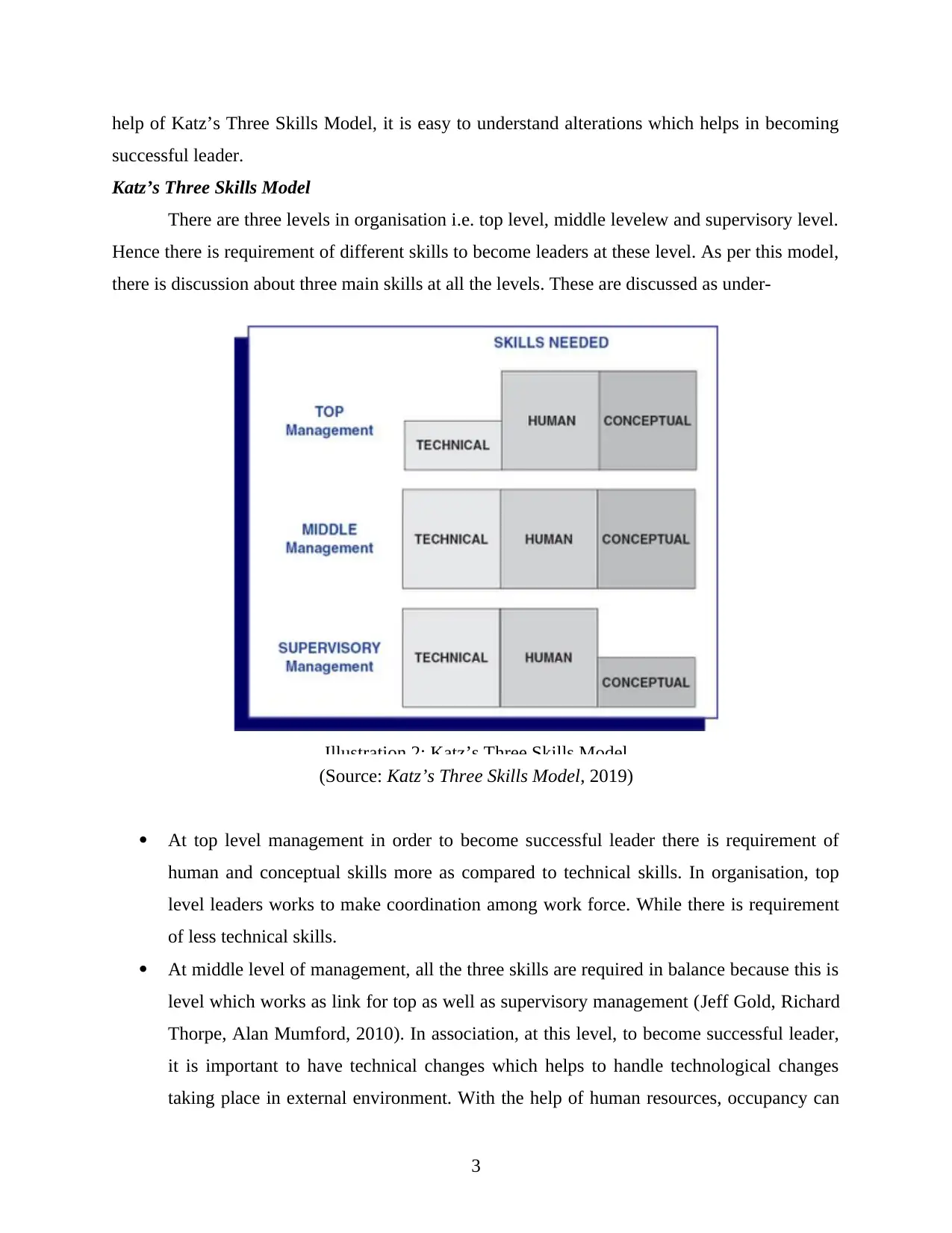
help of Katz’s Three Skills Model, it is easy to understand alterations which helps in becoming
successful leader.
Katz’s Three Skills Model
There are three levels in organisation i.e. top level, middle levelew and supervisory level.
Hence there is requirement of different skills to become leaders at these level. As per this model,
there is discussion about three main skills at all the levels. These are discussed as under-
(Source: Katz’s Three Skills Model, 2019)
At top level management in order to become successful leader there is requirement of
human and conceptual skills more as compared to technical skills. In organisation, top
level leaders works to make coordination among work force. While there is requirement
of less technical skills.
At middle level of management, all the three skills are required in balance because this is
level which works as link for top as well as supervisory management (Jeff Gold, Richard
Thorpe, Alan Mumford, 2010). In association, at this level, to become successful leader,
it is important to have technical changes which helps to handle technological changes
taking place in external environment. With the help of human resources, occupancy can
3
Illustration 2: Katz’s Three Skills Model
successful leader.
Katz’s Three Skills Model
There are three levels in organisation i.e. top level, middle levelew and supervisory level.
Hence there is requirement of different skills to become leaders at these level. As per this model,
there is discussion about three main skills at all the levels. These are discussed as under-
(Source: Katz’s Three Skills Model, 2019)
At top level management in order to become successful leader there is requirement of
human and conceptual skills more as compared to technical skills. In organisation, top
level leaders works to make coordination among work force. While there is requirement
of less technical skills.
At middle level of management, all the three skills are required in balance because this is
level which works as link for top as well as supervisory management (Jeff Gold, Richard
Thorpe, Alan Mumford, 2010). In association, at this level, to become successful leader,
it is important to have technical changes which helps to handle technological changes
taking place in external environment. With the help of human resources, occupancy can
3
Illustration 2: Katz’s Three Skills Model
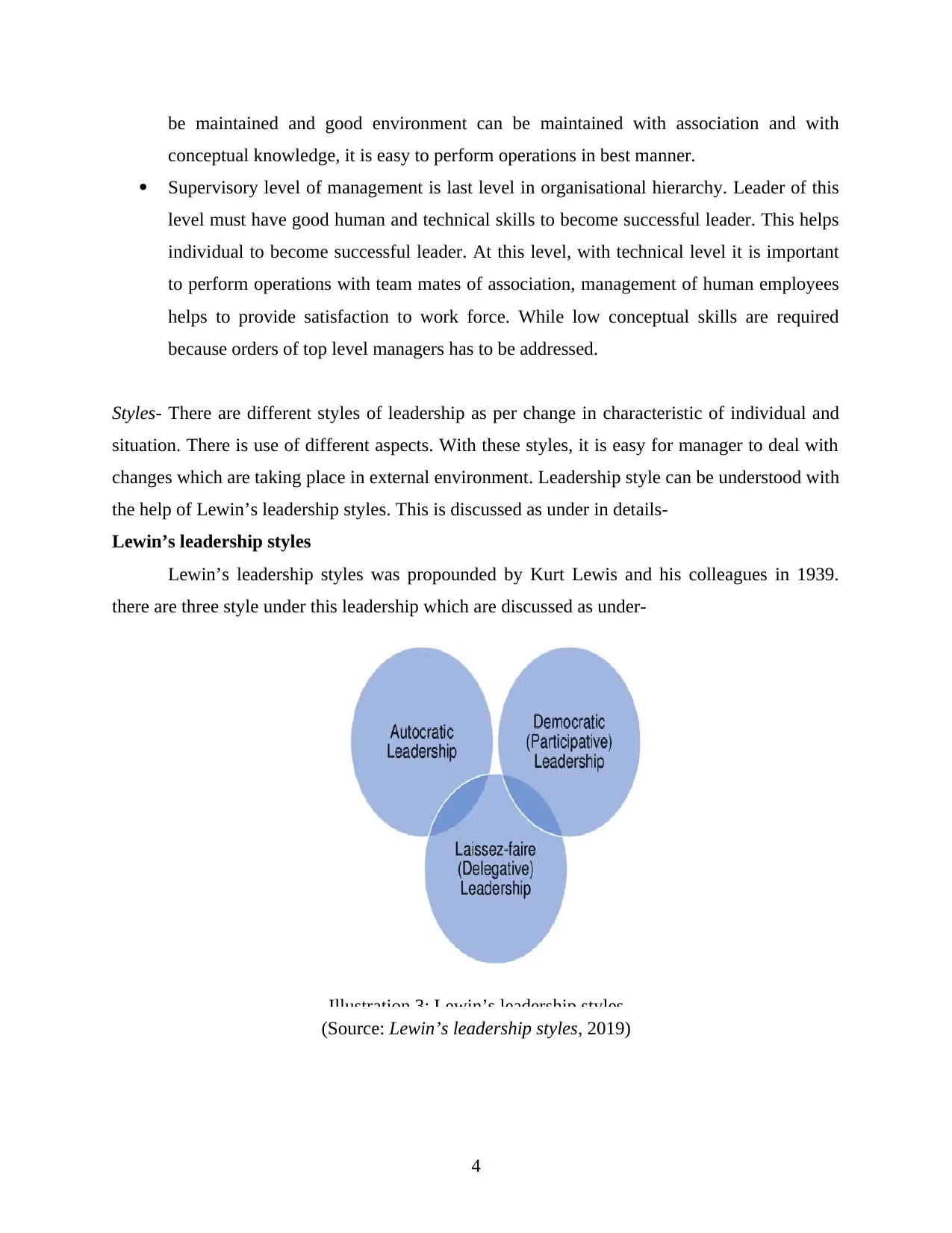
be maintained and good environment can be maintained with association and with
conceptual knowledge, it is easy to perform operations in best manner.
Supervisory level of management is last level in organisational hierarchy. Leader of this
level must have good human and technical skills to become successful leader. This helps
individual to become successful leader. At this level, with technical level it is important
to perform operations with team mates of association, management of human employees
helps to provide satisfaction to work force. While low conceptual skills are required
because orders of top level managers has to be addressed.
Styles- There are different styles of leadership as per change in characteristic of individual and
situation. There is use of different aspects. With these styles, it is easy for manager to deal with
changes which are taking place in external environment. Leadership style can be understood with
the help of Lewin’s leadership styles. This is discussed as under in details-
Lewin’s leadership styles
Lewin’s leadership styles was propounded by Kurt Lewis and his colleagues in 1939.
there are three style under this leadership which are discussed as under-
(Source: Lewin’s leadership styles, 2019)
4
Illustration 3: Lewin’s leadership styles
conceptual knowledge, it is easy to perform operations in best manner.
Supervisory level of management is last level in organisational hierarchy. Leader of this
level must have good human and technical skills to become successful leader. This helps
individual to become successful leader. At this level, with technical level it is important
to perform operations with team mates of association, management of human employees
helps to provide satisfaction to work force. While low conceptual skills are required
because orders of top level managers has to be addressed.
Styles- There are different styles of leadership as per change in characteristic of individual and
situation. There is use of different aspects. With these styles, it is easy for manager to deal with
changes which are taking place in external environment. Leadership style can be understood with
the help of Lewin’s leadership styles. This is discussed as under in details-
Lewin’s leadership styles
Lewin’s leadership styles was propounded by Kurt Lewis and his colleagues in 1939.
there are three style under this leadership which are discussed as under-
(Source: Lewin’s leadership styles, 2019)
4
Illustration 3: Lewin’s leadership styles
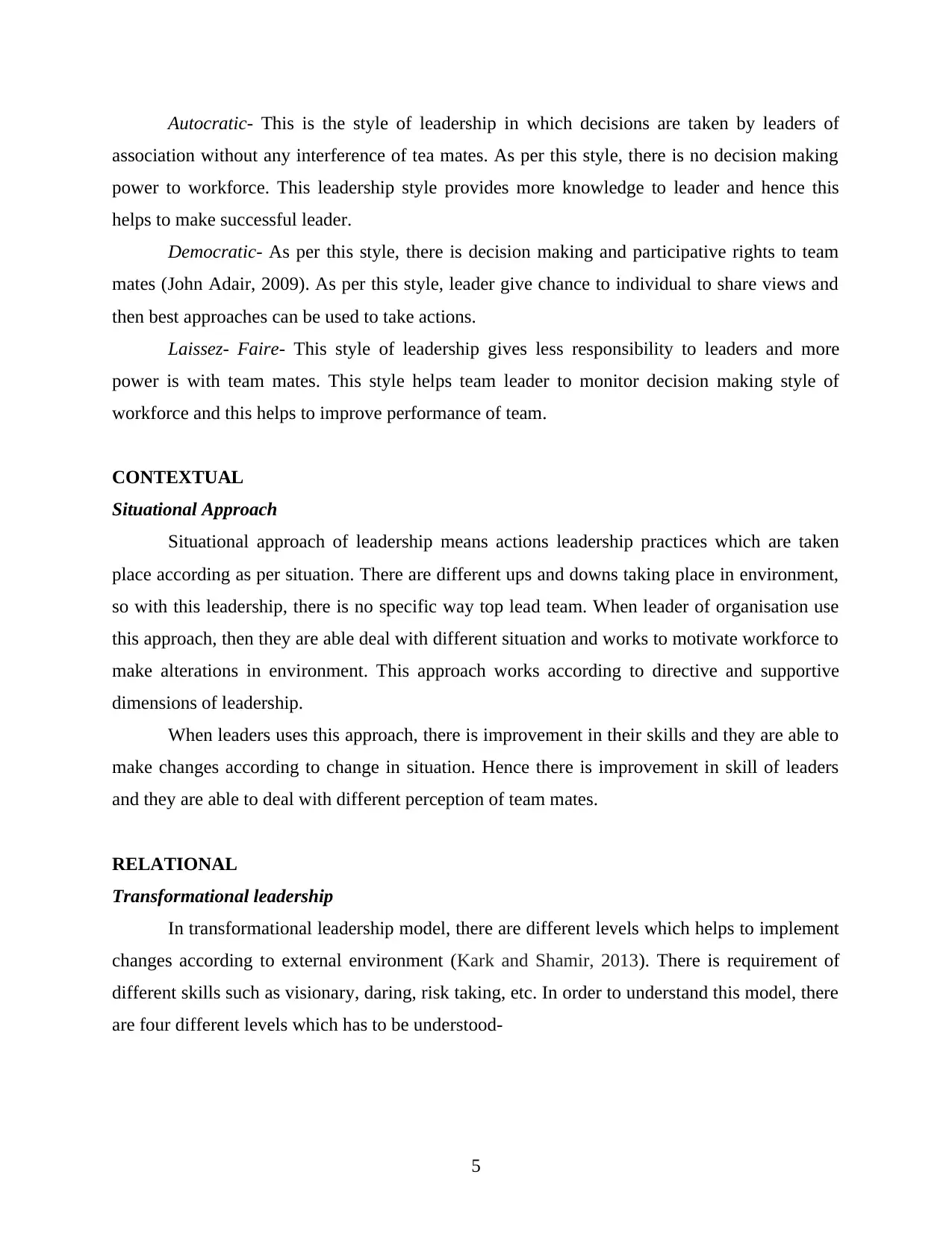
Autocratic- This is the style of leadership in which decisions are taken by leaders of
association without any interference of tea mates. As per this style, there is no decision making
power to workforce. This leadership style provides more knowledge to leader and hence this
helps to make successful leader.
Democratic- As per this style, there is decision making and participative rights to team
mates (John Adair, 2009). As per this style, leader give chance to individual to share views and
then best approaches can be used to take actions.
Laissez- Faire- This style of leadership gives less responsibility to leaders and more
power is with team mates. This style helps team leader to monitor decision making style of
workforce and this helps to improve performance of team.
CONTEXTUAL
Situational Approach
Situational approach of leadership means actions leadership practices which are taken
place according as per situation. There are different ups and downs taking place in environment,
so with this leadership, there is no specific way top lead team. When leader of organisation use
this approach, then they are able deal with different situation and works to motivate workforce to
make alterations in environment. This approach works according to directive and supportive
dimensions of leadership.
When leaders uses this approach, there is improvement in their skills and they are able to
make changes according to change in situation. Hence there is improvement in skill of leaders
and they are able to deal with different perception of team mates.
RELATIONAL
Transformational leadership
In transformational leadership model, there are different levels which helps to implement
changes according to external environment (Kark and Shamir, 2013). There is requirement of
different skills such as visionary, daring, risk taking, etc. In order to understand this model, there
are four different levels which has to be understood-
5
association without any interference of tea mates. As per this style, there is no decision making
power to workforce. This leadership style provides more knowledge to leader and hence this
helps to make successful leader.
Democratic- As per this style, there is decision making and participative rights to team
mates (John Adair, 2009). As per this style, leader give chance to individual to share views and
then best approaches can be used to take actions.
Laissez- Faire- This style of leadership gives less responsibility to leaders and more
power is with team mates. This style helps team leader to monitor decision making style of
workforce and this helps to improve performance of team.
CONTEXTUAL
Situational Approach
Situational approach of leadership means actions leadership practices which are taken
place according as per situation. There are different ups and downs taking place in environment,
so with this leadership, there is no specific way top lead team. When leader of organisation use
this approach, then they are able deal with different situation and works to motivate workforce to
make alterations in environment. This approach works according to directive and supportive
dimensions of leadership.
When leaders uses this approach, there is improvement in their skills and they are able to
make changes according to change in situation. Hence there is improvement in skill of leaders
and they are able to deal with different perception of team mates.
RELATIONAL
Transformational leadership
In transformational leadership model, there are different levels which helps to implement
changes according to external environment (Kark and Shamir, 2013). There is requirement of
different skills such as visionary, daring, risk taking, etc. In order to understand this model, there
are four different levels which has to be understood-
5
Paraphrase This Document
Need a fresh take? Get an instant paraphrase of this document with our AI Paraphraser

(Source: Transformational leadership, 2018)
First level is inspirational motivation. In this stage leader must motivate employees by
analysing vision, mission s and values of association. In this stage leader must analyse
different aspects through which they can communicate new team spirit in work force.
Intellectual Stimulation is the second stage of transformational model. In this leader
motivate employees to implement different aspects for resolving issues taking place in
environment.
Idealized influence is next stage in transformational model. As per this, team mates
perform operations according to direction and guidance of leaders. Under this stage
leaders are able to gain good impression, in front of team mates (Kelloway and et. al.,
2012).
Individualized Consideration is last stage in transformational model. In this stage, leader
is mentor for team mates an there is provision of reward system in case of new and
innovative working approach. In this team mates acts according to their skills, knowledge
and experience which makes them different from one another.
6
Illustration 4: Transformational leadership
First level is inspirational motivation. In this stage leader must motivate employees by
analysing vision, mission s and values of association. In this stage leader must analyse
different aspects through which they can communicate new team spirit in work force.
Intellectual Stimulation is the second stage of transformational model. In this leader
motivate employees to implement different aspects for resolving issues taking place in
environment.
Idealized influence is next stage in transformational model. As per this, team mates
perform operations according to direction and guidance of leaders. Under this stage
leaders are able to gain good impression, in front of team mates (Kelloway and et. al.,
2012).
Individualized Consideration is last stage in transformational model. In this stage, leader
is mentor for team mates an there is provision of reward system in case of new and
innovative working approach. In this team mates acts according to their skills, knowledge
and experience which makes them different from one another.
6
Illustration 4: Transformational leadership
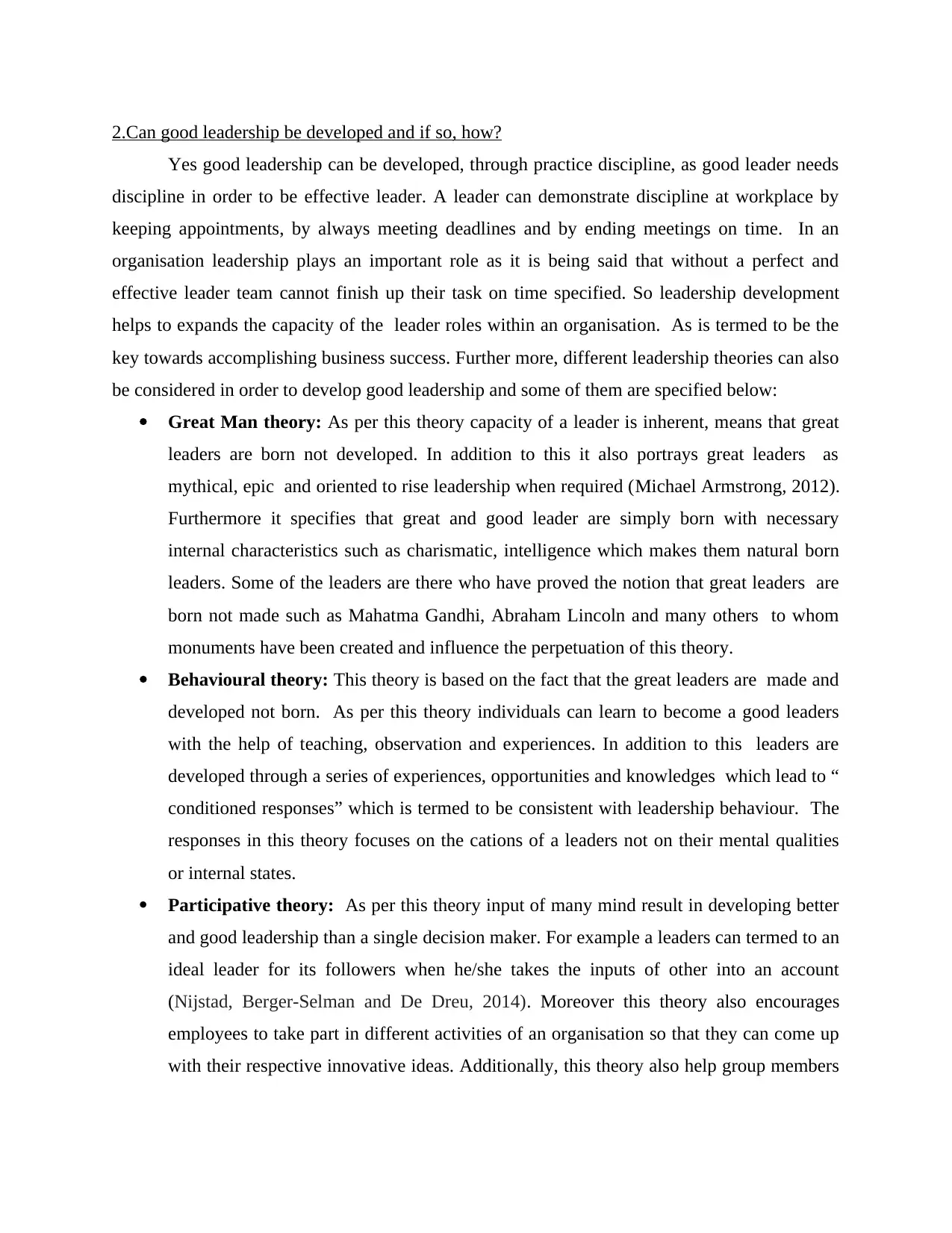
2.Can good leadership be developed and if so, how?
Yes good leadership can be developed, through practice discipline, as good leader needs
discipline in order to be effective leader. A leader can demonstrate discipline at workplace by
keeping appointments, by always meeting deadlines and by ending meetings on time. In an
organisation leadership plays an important role as it is being said that without a perfect and
effective leader team cannot finish up their task on time specified. So leadership development
helps to expands the capacity of the leader roles within an organisation. As is termed to be the
key towards accomplishing business success. Further more, different leadership theories can also
be considered in order to develop good leadership and some of them are specified below:
Great Man theory: As per this theory capacity of a leader is inherent, means that great
leaders are born not developed. In addition to this it also portrays great leaders as
mythical, epic and oriented to rise leadership when required (Michael Armstrong, 2012).
Furthermore it specifies that great and good leader are simply born with necessary
internal characteristics such as charismatic, intelligence which makes them natural born
leaders. Some of the leaders are there who have proved the notion that great leaders are
born not made such as Mahatma Gandhi, Abraham Lincoln and many others to whom
monuments have been created and influence the perpetuation of this theory.
Behavioural theory: This theory is based on the fact that the great leaders are made and
developed not born. As per this theory individuals can learn to become a good leaders
with the help of teaching, observation and experiences. In addition to this leaders are
developed through a series of experiences, opportunities and knowledges which lead to “
conditioned responses” which is termed to be consistent with leadership behaviour. The
responses in this theory focuses on the cations of a leaders not on their mental qualities
or internal states.
Participative theory: As per this theory input of many mind result in developing better
and good leadership than a single decision maker. For example a leaders can termed to an
ideal leader for its followers when he/she takes the inputs of other into an account
(Nijstad, Berger-Selman and De Dreu, 2014). Moreover this theory also encourages
employees to take part in different activities of an organisation so that they can come up
with their respective innovative ideas. Additionally, this theory also help group members
Yes good leadership can be developed, through practice discipline, as good leader needs
discipline in order to be effective leader. A leader can demonstrate discipline at workplace by
keeping appointments, by always meeting deadlines and by ending meetings on time. In an
organisation leadership plays an important role as it is being said that without a perfect and
effective leader team cannot finish up their task on time specified. So leadership development
helps to expands the capacity of the leader roles within an organisation. As is termed to be the
key towards accomplishing business success. Further more, different leadership theories can also
be considered in order to develop good leadership and some of them are specified below:
Great Man theory: As per this theory capacity of a leader is inherent, means that great
leaders are born not developed. In addition to this it also portrays great leaders as
mythical, epic and oriented to rise leadership when required (Michael Armstrong, 2012).
Furthermore it specifies that great and good leader are simply born with necessary
internal characteristics such as charismatic, intelligence which makes them natural born
leaders. Some of the leaders are there who have proved the notion that great leaders are
born not made such as Mahatma Gandhi, Abraham Lincoln and many others to whom
monuments have been created and influence the perpetuation of this theory.
Behavioural theory: This theory is based on the fact that the great leaders are made and
developed not born. As per this theory individuals can learn to become a good leaders
with the help of teaching, observation and experiences. In addition to this leaders are
developed through a series of experiences, opportunities and knowledges which lead to “
conditioned responses” which is termed to be consistent with leadership behaviour. The
responses in this theory focuses on the cations of a leaders not on their mental qualities
or internal states.
Participative theory: As per this theory input of many mind result in developing better
and good leadership than a single decision maker. For example a leaders can termed to an
ideal leader for its followers when he/she takes the inputs of other into an account
(Nijstad, Berger-Selman and De Dreu, 2014). Moreover this theory also encourages
employees to take part in different activities of an organisation so that they can come up
with their respective innovative ideas. Additionally, this theory also help group members
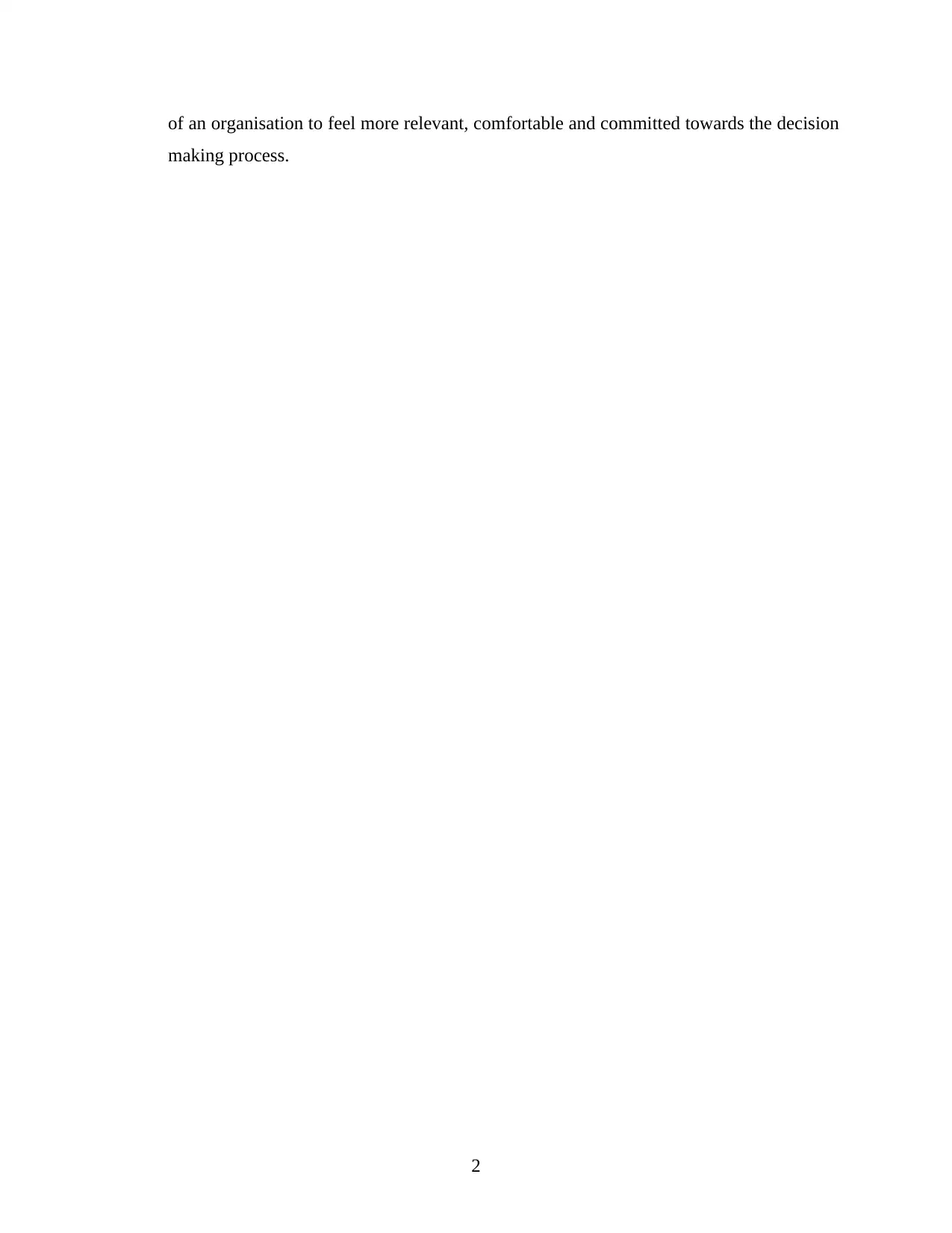
of an organisation to feel more relevant, comfortable and committed towards the decision
making process.
2
making process.
2
Secure Best Marks with AI Grader
Need help grading? Try our AI Grader for instant feedback on your assignments.
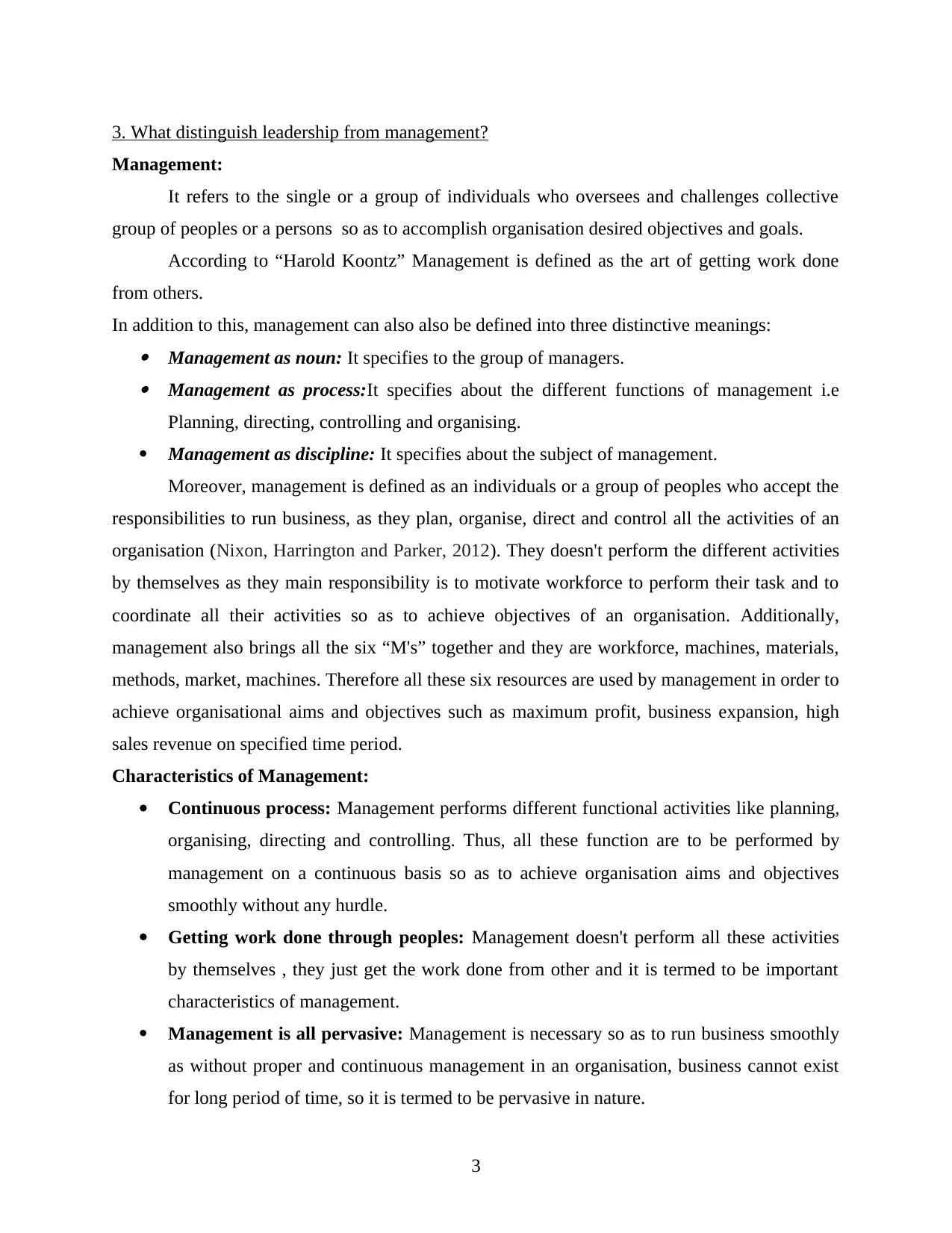
3. What distinguish leadership from management?
Management:
It refers to the single or a group of individuals who oversees and challenges collective
group of peoples or a persons so as to accomplish organisation desired objectives and goals.
According to “Harold Koontz” Management is defined as the art of getting work done
from others.
In addition to this, management can also also be defined into three distinctive meanings: Management as noun: It specifies to the group of managers. Management as process:It specifies about the different functions of management i.e
Planning, directing, controlling and organising.
Management as discipline: It specifies about the subject of management.
Moreover, management is defined as an individuals or a group of peoples who accept the
responsibilities to run business, as they plan, organise, direct and control all the activities of an
organisation (Nixon, Harrington and Parker, 2012). They doesn't perform the different activities
by themselves as they main responsibility is to motivate workforce to perform their task and to
coordinate all their activities so as to achieve objectives of an organisation. Additionally,
management also brings all the six “M's” together and they are workforce, machines, materials,
methods, market, machines. Therefore all these six resources are used by management in order to
achieve organisational aims and objectives such as maximum profit, business expansion, high
sales revenue on specified time period.
Characteristics of Management:
Continuous process: Management performs different functional activities like planning,
organising, directing and controlling. Thus, all these function are to be performed by
management on a continuous basis so as to achieve organisation aims and objectives
smoothly without any hurdle.
Getting work done through peoples: Management doesn't perform all these activities
by themselves , they just get the work done from other and it is termed to be important
characteristics of management.
Management is all pervasive: Management is necessary so as to run business smoothly
as without proper and continuous management in an organisation, business cannot exist
for long period of time, so it is termed to be pervasive in nature.
3
Management:
It refers to the single or a group of individuals who oversees and challenges collective
group of peoples or a persons so as to accomplish organisation desired objectives and goals.
According to “Harold Koontz” Management is defined as the art of getting work done
from others.
In addition to this, management can also also be defined into three distinctive meanings: Management as noun: It specifies to the group of managers. Management as process:It specifies about the different functions of management i.e
Planning, directing, controlling and organising.
Management as discipline: It specifies about the subject of management.
Moreover, management is defined as an individuals or a group of peoples who accept the
responsibilities to run business, as they plan, organise, direct and control all the activities of an
organisation (Nixon, Harrington and Parker, 2012). They doesn't perform the different activities
by themselves as they main responsibility is to motivate workforce to perform their task and to
coordinate all their activities so as to achieve objectives of an organisation. Additionally,
management also brings all the six “M's” together and they are workforce, machines, materials,
methods, market, machines. Therefore all these six resources are used by management in order to
achieve organisational aims and objectives such as maximum profit, business expansion, high
sales revenue on specified time period.
Characteristics of Management:
Continuous process: Management performs different functional activities like planning,
organising, directing and controlling. Thus, all these function are to be performed by
management on a continuous basis so as to achieve organisation aims and objectives
smoothly without any hurdle.
Getting work done through peoples: Management doesn't perform all these activities
by themselves , they just get the work done from other and it is termed to be important
characteristics of management.
Management is all pervasive: Management is necessary so as to run business smoothly
as without proper and continuous management in an organisation, business cannot exist
for long period of time, so it is termed to be pervasive in nature.
3
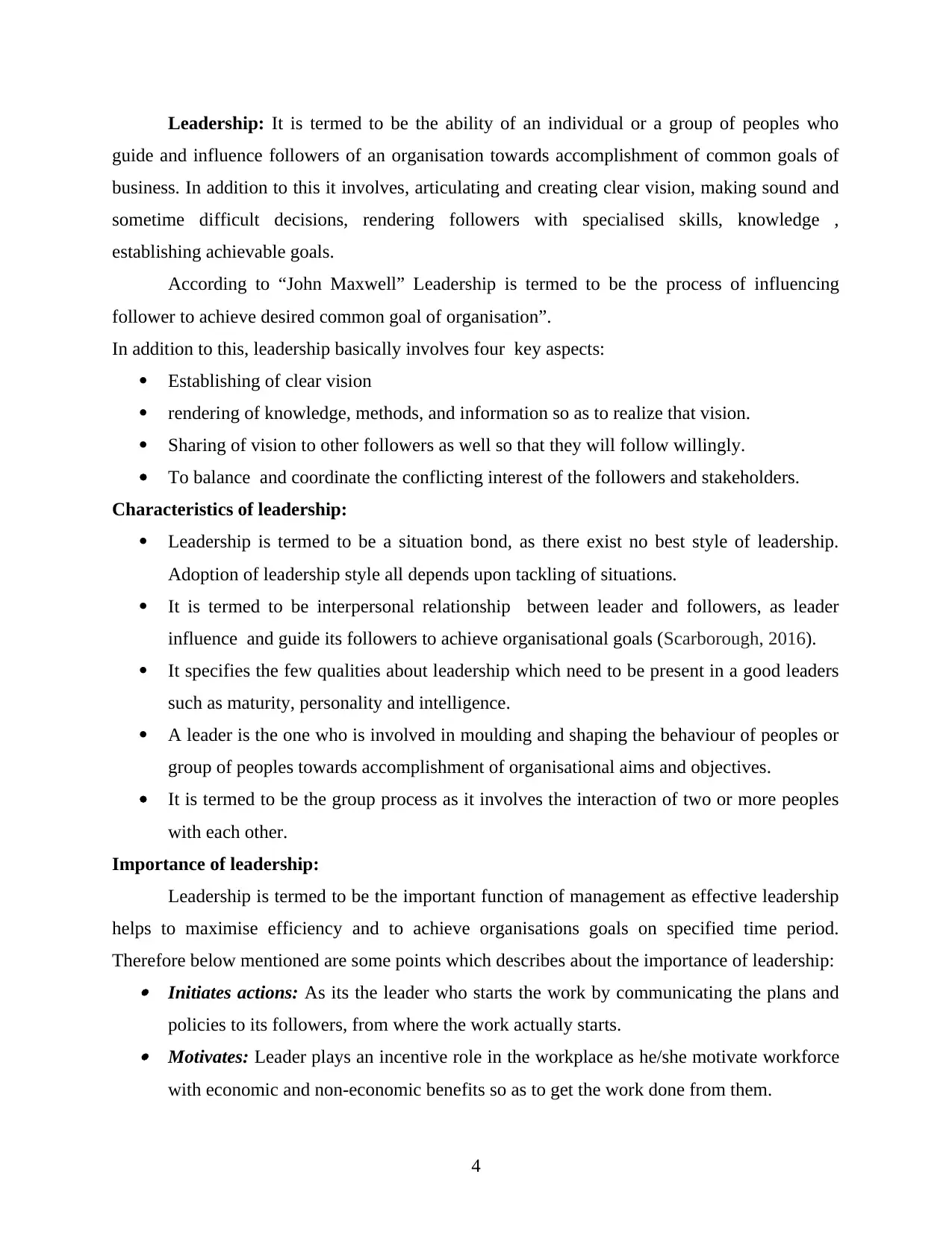
Leadership: It is termed to be the ability of an individual or a group of peoples who
guide and influence followers of an organisation towards accomplishment of common goals of
business. In addition to this it involves, articulating and creating clear vision, making sound and
sometime difficult decisions, rendering followers with specialised skills, knowledge ,
establishing achievable goals.
According to “John Maxwell” Leadership is termed to be the process of influencing
follower to achieve desired common goal of organisation”.
In addition to this, leadership basically involves four key aspects:
Establishing of clear vision
rendering of knowledge, methods, and information so as to realize that vision.
Sharing of vision to other followers as well so that they will follow willingly.
To balance and coordinate the conflicting interest of the followers and stakeholders.
Characteristics of leadership:
Leadership is termed to be a situation bond, as there exist no best style of leadership.
Adoption of leadership style all depends upon tackling of situations.
It is termed to be interpersonal relationship between leader and followers, as leader
influence and guide its followers to achieve organisational goals (Scarborough, 2016).
It specifies the few qualities about leadership which need to be present in a good leaders
such as maturity, personality and intelligence.
A leader is the one who is involved in moulding and shaping the behaviour of peoples or
group of peoples towards accomplishment of organisational aims and objectives.
It is termed to be the group process as it involves the interaction of two or more peoples
with each other.
Importance of leadership:
Leadership is termed to be the important function of management as effective leadership
helps to maximise efficiency and to achieve organisations goals on specified time period.
Therefore below mentioned are some points which describes about the importance of leadership: Initiates actions: As its the leader who starts the work by communicating the plans and
policies to its followers, from where the work actually starts. Motivates: Leader plays an incentive role in the workplace as he/she motivate workforce
with economic and non-economic benefits so as to get the work done from them.
4
guide and influence followers of an organisation towards accomplishment of common goals of
business. In addition to this it involves, articulating and creating clear vision, making sound and
sometime difficult decisions, rendering followers with specialised skills, knowledge ,
establishing achievable goals.
According to “John Maxwell” Leadership is termed to be the process of influencing
follower to achieve desired common goal of organisation”.
In addition to this, leadership basically involves four key aspects:
Establishing of clear vision
rendering of knowledge, methods, and information so as to realize that vision.
Sharing of vision to other followers as well so that they will follow willingly.
To balance and coordinate the conflicting interest of the followers and stakeholders.
Characteristics of leadership:
Leadership is termed to be a situation bond, as there exist no best style of leadership.
Adoption of leadership style all depends upon tackling of situations.
It is termed to be interpersonal relationship between leader and followers, as leader
influence and guide its followers to achieve organisational goals (Scarborough, 2016).
It specifies the few qualities about leadership which need to be present in a good leaders
such as maturity, personality and intelligence.
A leader is the one who is involved in moulding and shaping the behaviour of peoples or
group of peoples towards accomplishment of organisational aims and objectives.
It is termed to be the group process as it involves the interaction of two or more peoples
with each other.
Importance of leadership:
Leadership is termed to be the important function of management as effective leadership
helps to maximise efficiency and to achieve organisations goals on specified time period.
Therefore below mentioned are some points which describes about the importance of leadership: Initiates actions: As its the leader who starts the work by communicating the plans and
policies to its followers, from where the work actually starts. Motivates: Leader plays an incentive role in the workplace as he/she motivate workforce
with economic and non-economic benefits so as to get the work done from them.
4
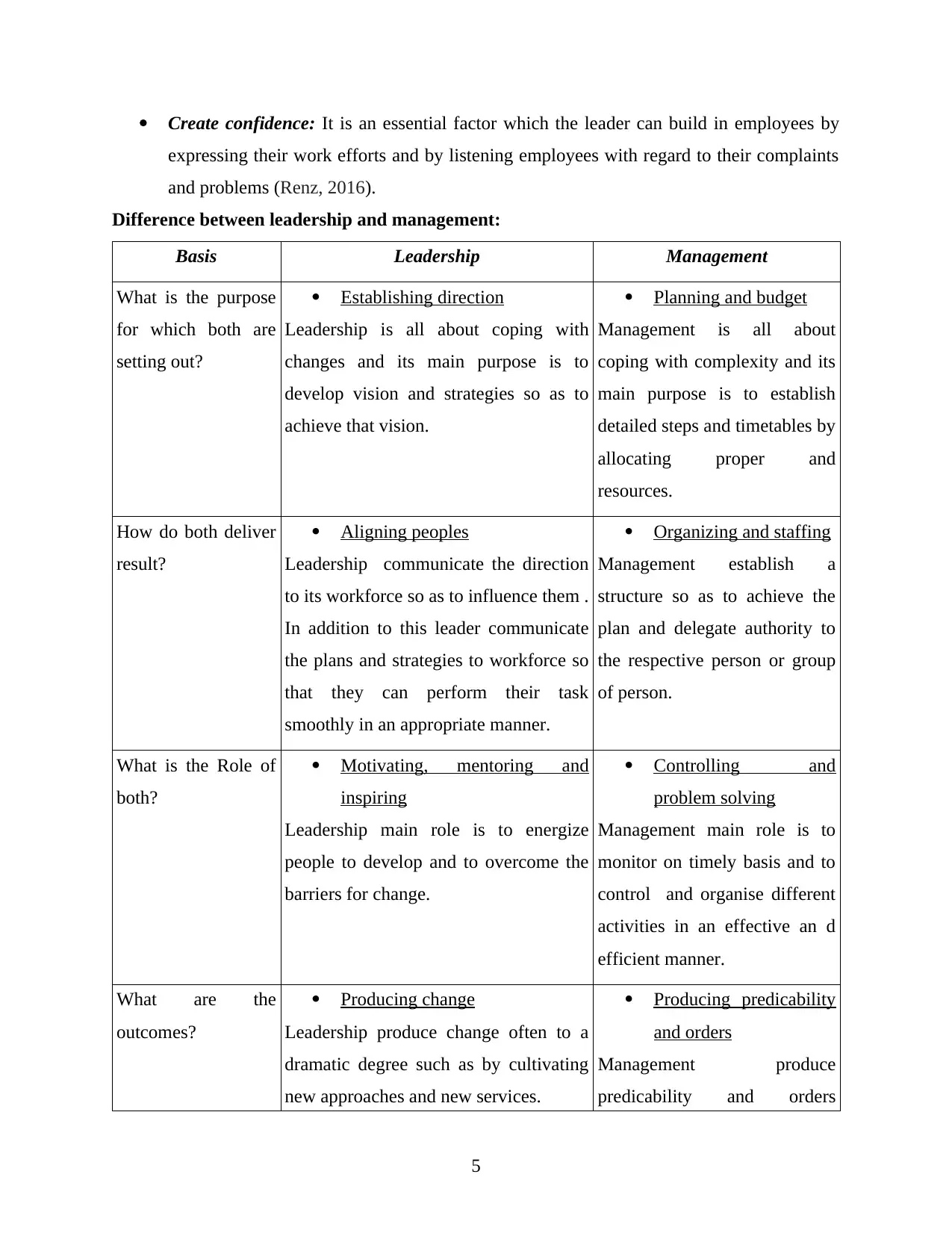
Create confidence: It is an essential factor which the leader can build in employees by
expressing their work efforts and by listening employees with regard to their complaints
and problems (Renz, 2016).
Difference between leadership and management:
Basis Leadership Management
What is the purpose
for which both are
setting out?
Establishing direction
Leadership is all about coping with
changes and its main purpose is to
develop vision and strategies so as to
achieve that vision.
Planning and budget
Management is all about
coping with complexity and its
main purpose is to establish
detailed steps and timetables by
allocating proper and
resources.
How do both deliver
result?
Aligning peoples
Leadership communicate the direction
to its workforce so as to influence them .
In addition to this leader communicate
the plans and strategies to workforce so
that they can perform their task
smoothly in an appropriate manner.
Organizing and staffing
Management establish a
structure so as to achieve the
plan and delegate authority to
the respective person or group
of person.
What is the Role of
both?
Motivating, mentoring and
inspiring
Leadership main role is to energize
people to develop and to overcome the
barriers for change.
Controlling and
problem solving
Management main role is to
monitor on timely basis and to
control and organise different
activities in an effective an d
efficient manner.
What are the
outcomes?
Producing change
Leadership produce change often to a
dramatic degree such as by cultivating
new approaches and new services.
Producing predicability
and orders
Management produce
predicability and orders
5
expressing their work efforts and by listening employees with regard to their complaints
and problems (Renz, 2016).
Difference between leadership and management:
Basis Leadership Management
What is the purpose
for which both are
setting out?
Establishing direction
Leadership is all about coping with
changes and its main purpose is to
develop vision and strategies so as to
achieve that vision.
Planning and budget
Management is all about
coping with complexity and its
main purpose is to establish
detailed steps and timetables by
allocating proper and
resources.
How do both deliver
result?
Aligning peoples
Leadership communicate the direction
to its workforce so as to influence them .
In addition to this leader communicate
the plans and strategies to workforce so
that they can perform their task
smoothly in an appropriate manner.
Organizing and staffing
Management establish a
structure so as to achieve the
plan and delegate authority to
the respective person or group
of person.
What is the Role of
both?
Motivating, mentoring and
inspiring
Leadership main role is to energize
people to develop and to overcome the
barriers for change.
Controlling and
problem solving
Management main role is to
monitor on timely basis and to
control and organise different
activities in an effective an d
efficient manner.
What are the
outcomes?
Producing change
Leadership produce change often to a
dramatic degree such as by cultivating
new approaches and new services.
Producing predicability
and orders
Management produce
predicability and orders
5
Paraphrase This Document
Need a fresh take? Get an instant paraphrase of this document with our AI Paraphraser

through consistently achieving
target and budgets.
For example:
An individual holding line management responsibility possess the following capabilities:
Leadership
Provide members with a vision of where we are going.
Empowers individuals to take responsibilities and ownership for jobs.
Inspire and motivate workforce to achieve success.
Influence individuals to share their ideas so as to make improvements in their own
and other performance.
Management
Review and monitor the performance of each individuals of staff.
To carry out regular appraisal reviews on the basis of performance.
To provide staff members with feedback of their performance – positive and
negative.
4)What have you learnt about leadership from your own experiences, on this course and
elsewhere?
I work as leader in organisation where I have 10 people under me. There are many ups
and down taking place in external environment, so it is not easy to deal with workforce and
motivate them to work well to attain organisational goals. In order to motivate them I use
monetary as well as non monetary benefits which are important for bridging gap between
individual and organisation goals.
I use situation al theory of leader because this helps me to deal with alterations in
situation which has been taking place in environment. There are positive as well as negative
revert from consumers in order to deal with it, I use democratic style, so work force is aware
about changes which are required to deal with those reverts.
I have learnt to become successful leader by analysing behaviour of employees and
taking actions which are important for creating good environment within team. With my
leadership all the team mates are satisfied because I behave familiar with them and understand
6
target and budgets.
For example:
An individual holding line management responsibility possess the following capabilities:
Leadership
Provide members with a vision of where we are going.
Empowers individuals to take responsibilities and ownership for jobs.
Inspire and motivate workforce to achieve success.
Influence individuals to share their ideas so as to make improvements in their own
and other performance.
Management
Review and monitor the performance of each individuals of staff.
To carry out regular appraisal reviews on the basis of performance.
To provide staff members with feedback of their performance – positive and
negative.
4)What have you learnt about leadership from your own experiences, on this course and
elsewhere?
I work as leader in organisation where I have 10 people under me. There are many ups
and down taking place in external environment, so it is not easy to deal with workforce and
motivate them to work well to attain organisational goals. In order to motivate them I use
monetary as well as non monetary benefits which are important for bridging gap between
individual and organisation goals.
I use situation al theory of leader because this helps me to deal with alterations in
situation which has been taking place in environment. There are positive as well as negative
revert from consumers in order to deal with it, I use democratic style, so work force is aware
about changes which are required to deal with those reverts.
I have learnt to become successful leader by analysing behaviour of employees and
taking actions which are important for creating good environment within team. With my
leadership all the team mates are satisfied because I behave familiar with them and understand
6

their view to deal with situation. This improves perform of association and team mates are
satisfied because they are responsible in this case.
CONCLUSION
From the above mentioned report it can be concluded that leadership and management
both plays an essential role in the overall development of an organisation at a global level. As
without proper leadership management cannot functions its different operational activities, thus,
it can be said that leadership and management both are interrelated with each other. In addition
to this it is very much essential for the leader to analyse the situation before adopting the
leadership style. Therefore proper leadership is must in order to run management smoothly
without any hurdle.
7
satisfied because they are responsible in this case.
CONCLUSION
From the above mentioned report it can be concluded that leadership and management
both plays an essential role in the overall development of an organisation at a global level. As
without proper leadership management cannot functions its different operational activities, thus,
it can be said that leadership and management both are interrelated with each other. In addition
to this it is very much essential for the leader to analyse the situation before adopting the
leadership style. Therefore proper leadership is must in order to run management smoothly
without any hurdle.
7

REFERENCES
Books and Journals
Avolio, B. J. and Yammarino, F. J. eds., 2013. Introduction to, and overview of, transformational
and charismatic leadership. In Transformational and Charismatic Leadership: The
Road Ahead 10th Anniversary Edition (pp. xxvii-xxxiii). Emerald Group Publishing
Limited.
Doh, J. P. and Quigley, N. R., 2014. Responsible leadership and stakeholder management:
Influence pathways and organizational outcomes. Academy of Management
Perspectives. 28(3). pp.255-274.
Harris, A., 2013. Teacher leadership and school improvement. In Effective leadership for school
improvement (pp. 82-93). Routledge.
Jeff Gold, Richard Thorpe, Alan Mumford (2010). Leadership and Management Development.
London: Kogan Page.
John Adair (2009) Effective Leadership. How to Be a Successful Leader. London: Pan
MacMillan.
Kark, R. and Shamir, B., 2013. The dual effect of transformational leadership: Priming relational
and collective selves and further effects on followers. In Transformational and
Charismatic Leadership: The Road Ahead 10th Anniversary Edition (pp. 77-101).
Emerald Group Publishing Limited.
Kelloway, E. K. and et. al., 2012. Transformational leadership and employee psychological well-
being: The mediating role of employee trust in leadership. Work & Stress. 26(1). pp.39-
55.
Michael Armstrong (2012) Armstrong’s Handbook of Management and Leadership: Developing
Effective People Skills for Better Leadership and Management. London: Kogan Page.
Nijstad, B. A., Berger-Selman, F. and De Dreu, C. K., 2014. Innovation in top management
teams: Minority dissent, transformational leadership, and radical innovations. European
journal of work and organizational psychology. 23(2), pp.310-322.
Nixon, P., Harrington, M. and Parker, D., 2012. Leadership performance is significant to project
success or failure: a critical analysis. International Journal of productivity and
performance management. 61(2). pp.204-216.
Renz, D. O., 2016. The Jossey-Bass handbook of nonprofit leadership and management. John
Wiley & Sons.
Scarborough, N. M., 2016. Essentials of entrepreneurship and small business management.
Pearson.
Online
Management. 2011. [Online]. Avaialble through:
<http://kalyan-city.blogspot.com/2011/04/what-is-management-definitions-
meaning.html>.
Leadership. 2018. [Online]. Avaialble through: <https://www.inc.com/christine-lagorio/3ve-
rebranding-russian-hackers.html>.
Three Skills Approach. 2019. [Online]. Available through:
<https://sites.psu.edu/leadership/2013/01/29/three-skills-approach/>.
8
Books and Journals
Avolio, B. J. and Yammarino, F. J. eds., 2013. Introduction to, and overview of, transformational
and charismatic leadership. In Transformational and Charismatic Leadership: The
Road Ahead 10th Anniversary Edition (pp. xxvii-xxxiii). Emerald Group Publishing
Limited.
Doh, J. P. and Quigley, N. R., 2014. Responsible leadership and stakeholder management:
Influence pathways and organizational outcomes. Academy of Management
Perspectives. 28(3). pp.255-274.
Harris, A., 2013. Teacher leadership and school improvement. In Effective leadership for school
improvement (pp. 82-93). Routledge.
Jeff Gold, Richard Thorpe, Alan Mumford (2010). Leadership and Management Development.
London: Kogan Page.
John Adair (2009) Effective Leadership. How to Be a Successful Leader. London: Pan
MacMillan.
Kark, R. and Shamir, B., 2013. The dual effect of transformational leadership: Priming relational
and collective selves and further effects on followers. In Transformational and
Charismatic Leadership: The Road Ahead 10th Anniversary Edition (pp. 77-101).
Emerald Group Publishing Limited.
Kelloway, E. K. and et. al., 2012. Transformational leadership and employee psychological well-
being: The mediating role of employee trust in leadership. Work & Stress. 26(1). pp.39-
55.
Michael Armstrong (2012) Armstrong’s Handbook of Management and Leadership: Developing
Effective People Skills for Better Leadership and Management. London: Kogan Page.
Nijstad, B. A., Berger-Selman, F. and De Dreu, C. K., 2014. Innovation in top management
teams: Minority dissent, transformational leadership, and radical innovations. European
journal of work and organizational psychology. 23(2), pp.310-322.
Nixon, P., Harrington, M. and Parker, D., 2012. Leadership performance is significant to project
success or failure: a critical analysis. International Journal of productivity and
performance management. 61(2). pp.204-216.
Renz, D. O., 2016. The Jossey-Bass handbook of nonprofit leadership and management. John
Wiley & Sons.
Scarborough, N. M., 2016. Essentials of entrepreneurship and small business management.
Pearson.
Online
Management. 2011. [Online]. Avaialble through:
<http://kalyan-city.blogspot.com/2011/04/what-is-management-definitions-
meaning.html>.
Leadership. 2018. [Online]. Avaialble through: <https://www.inc.com/christine-lagorio/3ve-
rebranding-russian-hackers.html>.
Three Skills Approach. 2019. [Online]. Available through:
<https://sites.psu.edu/leadership/2013/01/29/three-skills-approach/>.
8
Secure Best Marks with AI Grader
Need help grading? Try our AI Grader for instant feedback on your assignments.

Lewin’s leadership styles. 2019. [Online]. Available through:
<http://changingminds.org/disciplines/leadership/styles/lewin_style.htm>.
9
<http://changingminds.org/disciplines/leadership/styles/lewin_style.htm>.
9
1 out of 17
Related Documents
Your All-in-One AI-Powered Toolkit for Academic Success.
+13062052269
info@desklib.com
Available 24*7 on WhatsApp / Email
![[object Object]](/_next/static/media/star-bottom.7253800d.svg)
Unlock your academic potential
© 2024 | Zucol Services PVT LTD | All rights reserved.





